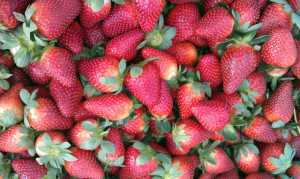Growers Playing Vital Role In Organic Strawberry Study

Photo by Michael Schwieterman, UF/IFAS
After the first year of a University of Florida study to try to develop new organic strawberry production systems, growers are playing a critical role in setting priorities for the research project’s future.
The study stemmed from several issues strawberry growers face. Rising costs of production and increased imports of strawberries threaten the sustainability of the Florida strawberry industry. Demand for organic strawberries is growing and brings a price premium for growers who can master the art and science of organic strawberry production.
Organic and conventional growers assessed parts of the first year of research, said Mickie Swisher, associate professor of sustainable agriculture in UF’s Department of Family, Youth and Community Sciences and a member of the Institute of Food and Agricultural Sciences (IFAS).
Two assessments were done at the UF/IFAS Plant Science Research and Education Unit in Citra, and at a farm in Plant City. The third assessment relied on posters with pictures and data and was collected by the Florida Certified Organic Growers and Consumers Inc. (FOG) at the Southern Sustainable Agriculture Working Group conference in Mobile, AL.
UF researchers are working with scientists from North Carolina A&T, FOG and Driscoll Strawberry Associates Inc. They’re trying to help growers who want to gain a foothold in the organic market, Swisher said.
The research teams, funded by a grant from the Walmart Foundation and administered by the University of Arkansas System Division of Agriculture Center for Agricultural and Rural Sustainability, are trying to develop new organic strawberry production systems.
Rather than focusing on isolated problems, such as weed management, the UF teams worked with growers and industry leaders to develop solutions to growers’ most critical needs.
The result is a research project that combines cultivar selection, soil and weed management, pest management, and evaluation of consumer preferences, Swisher said. Two types of systems were tested, one in open fields and one in a high tunnel. This approach allows researchers to answer the kinds of questions that organic and conventional growers commonly face about how a change in one component of a farming system will affect other elements.
Growers spent up to an hour making observations in field assessments. They started by considering how well the four cover crops that were tested suppressed weeds. Then they examined how eight strawberry cultivars performed in the field, focusing on plant vigor, fruit production, and disease and pest resistance, Swisher said. These advisers pooled their observations to make four recommendations for future research priorities to the research team.
One priority will be to use cover crops to suppress weeds and nematodes and improve soil health, but the practice can be costly because of the added cost of buying and planting seed for the cover crop. Growers suggested trying some cover crops, like pearl millet, that would give the grower a chance to harvest and sell the seed or grain to offset the cost.
Growers also want to know more about the effects of cover crops on the soil. A key priority was to know how much of the strawberry’s fertilizer requirements can be met by nutrients released when the cover crops are plowed in and decayed.
They also want to know more about the interactions between cover crops, strawberry cultivars and disease and insect and mite pests. They pointed out that the incidence of diseases and pests varied between the open field and high-tunnel systems, opening up more questions about the differences in the two systems.
In addition, growers have asked the researchers to develop economic models of the costs of production, yield, and net return for each combination of cover crop and strawberry cultivar.
Answering the new questions raised by growers is essential to developing sustainable and organic strawberry production systems. Carlene Chase, the research team’s leader, has indicated that the team is already planning next year’s research program, incorporating all of these critical recommendations.









